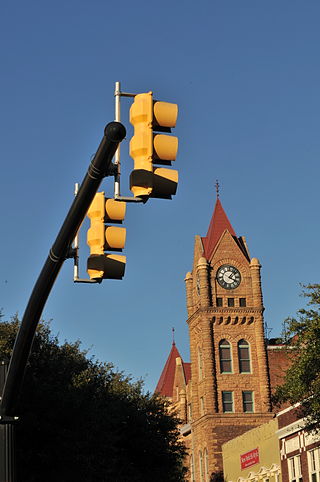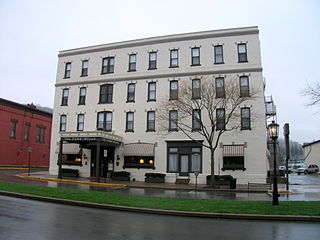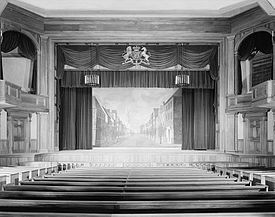
Ford's Theatre is a theater located in Washington, D.C., which opened in 1863. The theater is best known for being the site of the assassination of Abraham Lincoln. On the night of April 14, 1865, John Wilkes Booth entered the theater box where Lincoln was watching a performance of Tom Taylor's play Our American Cousin, slipped the single-shot, 5.87-inch derringer from his pocket and fired at Lincoln's head. After being shot, the fatally wounded Lincoln was carried across the street to the nearby Petersen House, where he died the next morning.

The Tennessee Theatre is a movie palace in downtown Knoxville, Tennessee. The theater was built in 1928 in the 1908 Burwell Building, considered Knoxville's first skyscraper. The theater and Burwell Building were added to the National Register of Historic Places in 1982, and the theater was extensively restored in the early 2000s. The Tennessee Theatre currently focuses on hosting performing arts events and classic films, and is home to the Knoxville Opera and the Knoxville Symphony Orchestra. The theater is managed by AC Entertainment.

The Stephen Collins Foster Memorial is a performing arts center and museum which houses the Stephen Foster Archives at the University of Pittsburgh in Pittsburgh, Pennsylvania, USA. It is dedicated to the life and works of American songwriter Stephen Foster.

The Newberry Opera House, located in Newberry, South Carolina, is a fully restored historic building that is a live-performance space for popular artists, touring theatre companies, and local organizations. It is listed on the National Register of Historic Places in 1969.

Proctor's Theatre is a theatre and former vaudeville house located in Schenectady, New York, United States. Many famous artists have performed there, including Mariah Carey, Britney Spears, Hal Holbrook, Ted Wiles, and George Burns, as well as many others. It has one of the largest movie screens in the Northeast.

The Missouri Theatre, is a concert and entertainment venue in downtown Columbia, Missouri, occupying most of a city block between 9th street between Locust and Elm Streets. It was designed after the Opéra Garnier by the Boller Brothers, built in 1928, and is on the National Register of Historic Places. It is Columbia's only surviving pre-Depression movie palace and vaudeville stage. In 2011, the University of Missouri began a three-year lease of the facility. The Missouri Theatre is the resident home of the Missouri Symphony Orchestra, and is also frequently used by University of Missouri and civic groups. As of July 1, 2014, The University of Missouri took over ownership of the Missouri Theatre. It is one of the main performance venues for the University of Missouri School of Music.

The Bijou Theatre is a theater located in Knoxville, Tennessee, United States. Built in 1909 as an addition to the Lamar House Hotel, the theater has at various times served as performance venue for traditional theatre, vaudeville, a second-run moviehouse, a commencement stage for the city's African-American high school, and a pornographic movie theater. The Lamar House Hotel, in which the theater was constructed, was originally built in 1817, and modified in the 1850s. The building and theater were added to the National Register of Historic Places in 1975.

The Palace Theatre was a historic movie palace in downtown Cincinnati, Ohio, United States. Constructed at the dawn of the Roaring Twenties, it originally housed stage acts before conversion into a movie theater. Named a historic site because of its architecture, it was demolished in the early 1980s following years of financial failures.

The Landmark Theatre, originally known as Loew's State Theater, is a historic theater from the era of movie palaces, located on South Salina Street in Syracuse, New York, United States. Designed by Thomas W. Lamb, it is the city's only surviving example of the opulent theatrical venues of the 1920s. The Landmark is on the National Register of Historic Places.

William Lee Stoddart (1868–1940) was an architect who designed urban hotels in the Eastern United States. Although he was born in Tenafly, New Jersey, most of his commissions were in the South. He maintained offices in Atlanta and New York City.

The Bama Theatre is a historic theatre in Tuscaloosa, Alabama that currently serves as the city's performing arts center. Its modern redevelopment is the result of cooperation between the Arts Council of Tuscaloosa and the Tuscaloosa County Parks and Recreation Authority. The three-story brick and limestone building is located at the corner of Gary Fitts Street and Greensboro Avenue in downtown Tuscaloosa. It was added to the National Register of Historic Places (NRHP) on August 30, 1984. It is also a contributing building in the Downtown Tuscaloosa Historic District, NRHP-listed in 1985.

The Standard Theatre, now known as the Folly Theater and also known as the Century Theater and Shubert's Missouri, is a former vaudeville hall in downtown Kansas City, Missouri. Built in 1900, it was designed by Kansas City architect Louis S. Curtiss. The theater was associated with the adjoining Edward Hotel, which was also designed by Curtiss; the hotel was demolished in 1965.

The Mississippi Lofts and Adler Theatre is an apartment building and theater complex located in downtown Davenport, Iowa, United States. It is individually listed on the National Register of Historic Places by its original name, the Hotel Mississippi and RKO Orpheum Theater. The Hotel Mississippi was listed on the Davenport Register of Historic Properties in 2005. In 2020 the complex was included as a contributing property in the Davenport Downtown Commercial Historic District.

Old Greenville City Hall is a former building in Greenville, South Carolina, originally built as the U.S. Courthouse and Post Office in 1889 on the corner of Main and Broad Streets. Transferred to the city of Greenville in 1938, it served as the Greenville city hall. It was listed in the National Register of Historic Places on August 19, 1971, and was removed in 1973 after its demolition.
RiverCenter is a convention center located in downtown Davenport, Iowa, United States. It is made up of two buildings sited on the north and south sides of East Third Street connected by a skywalk. The Adler Theatre is connected to the original section of the convention center on the north side of the complex.

John Henry Devereux, also called John Delorey before 1860, was an American architect and builder best known for his designs in Charleston, South Carolina. According to the National Park Service, he was the "most prolific architect of the post-Civil War era" in the Charleston area. His works are listed on the U.S. National Register of Historic Places. His Charleston Post Office and Courthouse has been designated as a U.S. National Historic Landmark.

The Montgomery Building, listed on the National Register of Historic Places, is an iconic building located on Church Street in Spartanburg, Spartanburg County, South Carolina. It was built in 1924, and is a ten-story, nine-bay-wide, steel frame skyscraper faced in precast concrete. It originally housed the offices of textile companies, cotton brokers, and factories. The building also contained a theatre/auditorium space, a radio and television station. The Montgomery Building was the tallest building in Spartanburg until the 1950s. In 2016, a developer announced a $29 million plan to renovate the building for mixed-use to include apartments, offices and retail. Restoration began in Spring 2017 and was completed in December 2018.

Sumter Town Hall-Opera House, also known as the Sumter Academy of Music, is a historic town hall building located at Sumter, Sumter County, South Carolina. It was built in 1893, and is a four-story, ashlar brick Richardsonian Romanesque style building. It features a four-faced clock tower that serves as a focal point for the entire area. The building was remodeled internally in 1936, converting the first floor into a movie theater and the second floor opera house into offices.
Charleston Theatre, also called Broad Street Theatre was a theatre in Charleston, South Carolina between 1794 and 1833. It was the first permanent theatre in Charleston, the first with a permanent staff, and the only theater for much of its duration. It was succeeded by the New Charleston Theatre (1837–1861).

The Penn Wells Hotel in Wellsboro, Pennsylvania is listed on the National Registry of the Historic Hotels of America, is a contributing building that is part of the Wellsboro Historic District, and is also listed on the National Register of Historic Places.























